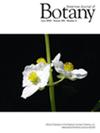Effects of anther-stigma position on cross-pollination efficiency in a hermaphroditic plant
Abstract
Premise
Evolution of cross-pollination efficiency depends on the genetic variation of flower traits, the pollen vector, and flower trait matching between pollen donors and recipients. Trait matching has been almost unexplored among nonheterostylous species, and we examined whether the match of anther length in pollen donors and stigma length in pollen recipients influences the efficiency of cross-pollination. To explore potential constraints for evolutionary response, we also quantified genetic variation and covariation among sepal length, petal length and width, stamen length, style length, and herkogamy.
Methods
We created 58 experimental arrays of Turnera velutina that varied in the extent of mismatch in the position of anthers and stigmas between single-flowered plants. Genetic variation and correlations among flower traits were estimated under greenhouse conditions.
Results
Style length, but not herkogamy, influenced the efficiency of cross-pollination. Plants with stamen length that matched the style length of other plants were more efficient pollen donors, whereas those with the style protruding above the stamens of other plants were more efficient pollen recipients. Significant broad-sense heritability (0.22 > hB2 < 0.42) and moderate genetic correlations (0.33 > r < 0.85) among floral traits were detected.
Conclusions
Our results demonstrated that anther-stigma mismatch between flowers contributed to variation in the efficiency of cross-pollination. The genetic correlations between stamen length and other floral traits suggests that any change in cross-pollination efficiency would be driven by changes in style rather than in stamen length.


 求助内容:
求助内容: 应助结果提醒方式:
应助结果提醒方式:


